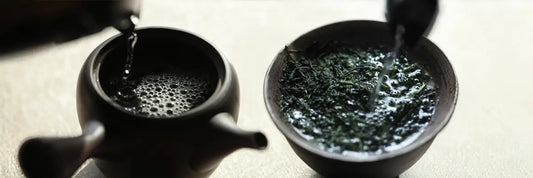Gyokuro taste can be difficult to explain to people, so we thought we would write a whole article about it!
In this article, you’ll learn what does gyokuro tea taste like and why it is able to develop such a distinct flavor profile.
You’ll see how much work goes into producing the unique gyokuro tea taste that has become famous all around the world.
So what does gyokuro tea taste like...?
The gyokuro taste is very unique in the world of tea. When people ask us what does gyokuro tea taste like, the first things that come to mind are actually foods, rather than other drinks.
Umami flavor
The savory or umami flavor gyokuro is known for is something more common in Japanese cuisine than it is in the world of tea.
The closest comparison for explaining the gyokuro tea taste is something like a bowl of miso soup. You get the rich, thick mouthfeel from the miso paste, the savory flavor from the tofu and mushrooms, a hint of salt and these marine or vegetal flavors from the seaweed.
This may sound like a lot to take in, particularly with a simple cup of tea, but the gyokuro tea taste is something tea lovers all around the world have fallen in love with. Once you develop a taste for gyokuro, there is no turning back!
Gyokuro aroma
There is a difference between the taste of a tea and the aroma.
The gyokuro tea taste is felt on the tongue as a physical reaction (think bitter, sweet, dry) but the gyokuro aroma is experienced by the nose through a phenomenon called retronasal olfaction.
When you’re drinking a tea, you actually smell it in reverse and this is how you get the more complex notes of the gyokuro flavor like seaweed and cantaloupe.
So what does gyokuro tea taste like? The taste is sweet and savory, but the gyokuro aroma can be so much more!
What creates the gyokuro tea taste?
The unique gyokuro flavor comes from a long and labor-intensive production process. Let's break down the production steps that impact the gyokuro taste:

Shading
First, the gyokuro plant needs to be covered with a special type of netting called a kabuse to block it from the sun.
When the tea plant is exposed to sunlight, it begins to convert theanine into catechins.
Catechins can protect the tea leaf from UV light, but they can also produce a bitter flavor in the final tea.
In order to minimize the production of catechins and maximize the content of sweet and savory theanine, the tea plant needs to be covered in order to block it from the sun.

Harvesting the top 3 leaves
After the tea leaves have been shaded for 3 weeks, they are ready to be harvested.
The farmer will only select the top 3 leaves of the tea plant, as these are thought to be the sweetest and smoothest in flavor.
They also are the most nutrient-dense part of the tea plant, so they produce the best gyokuro flavor.
Did you know that some people are even eating gyokuro leaves?
To learn more about it, read our article 👉 Why people are Eating Gyokuro Leaves?
Steaming process
After the leaves are harvested, they need to be steamed. This deactivates the enzymes that cause oxidation and prevents the tea from turning into a black tea. The steaming process locks in these marine or seaweed notes in the gyokuro tea taste.
Drying and rolling
After the leaves are steamed, they are partially dried and then rolled. The tea leaves need to be slightly pliable when they are rolled, and in the case of gyokuro they are actually taken through an additional rolling phase, which takes place in a special machine. This is how gyokuro tea is able to develop its distinct pine needle shape. Once the leaves have taken on their final shape, they are dried one last time to create finished gyokuro tea.
Is there any tea that tastes similar to gyokuro
There are really no other teas that can replicate the gyokuro taste. The closest you may get is with a long-shaded sencha like Kabuse sencha.

Kabuse sencha
Kabuse sencha is made from tea plants that have been shaded for 10 days or more.
As you know, to be considered a gyokuro tea the plant needs to be shaded for 21 days or more.
This means that kabuse sencha falls somewhere in between 10–20 days of shading.
So is there any tea that tastes similar to gyokuro? Kabusecha would be the closest, but even then there are differences.
Kabusecha vs. gyokuro
Compared to the gyokuro taste, the taste of kabuse sencha is much lighter. It does replicate the sweetness of the gyokuro, but without this strong umami or brothy flavor. This may be a positive for some people who have not quite developed the gyokuro tea taste.
If you are a fan of these strong savory or umami flavors, you really need that extra 2 weeks of shading in order to get it. The Gyokuro caffeine level will be higher compared to kabuse sencha as well.

Reasons why your gyokuro tastes bitter
Some people have told us that gyokuro tastes bitter, and there is one main reason for this. Gyokuro brewing temperature is extremely important. If you brew it too hot you will end up with a very bitter tea. This makes it very important to follow the gyokuro brewing parameters, particularly the temperature.
To prepare a cup of gyokuro tea, we recommend you use 5 grams of tea leaves, 150 ml of water, a temperature of 140°F (60°C) and a brewing time of 2 minutes. The reason you need a longer brewing time is that gyokuro tea is rolled more tightly into these needle shapes, and the leaves need a full 2 minutes to open up and release their flavor into the water.
Final thoughts on the gyokuro taste
The gyokuro taste is certainly an acquired one, but once you get it nothing else will come close to satisfying it. Gyokuro has a heavy and thick mouthfeel with a rich savory flavor and a smooth finish. It also has plenty of sweetness to it. It is rare to find a drink that has the complexity and nuance of a full meal, but gyokuro seems to pull it off beautifully.

Where to buy the tastiest gyokuro?
Now that you know what does gyokuro taste like, you are ready to prepare your own! Where to buy gyokuro green tea is a question we often get asked, and the answer is a bit complicated.
We wrote an entire article in which we will teach you everything you need to know before you buy gyokuro, how to buy gyokuro green tea and where to buy gyokuro. If you want to read it, here is the link for the article 👉 Where to buy gyokuro green tea.




